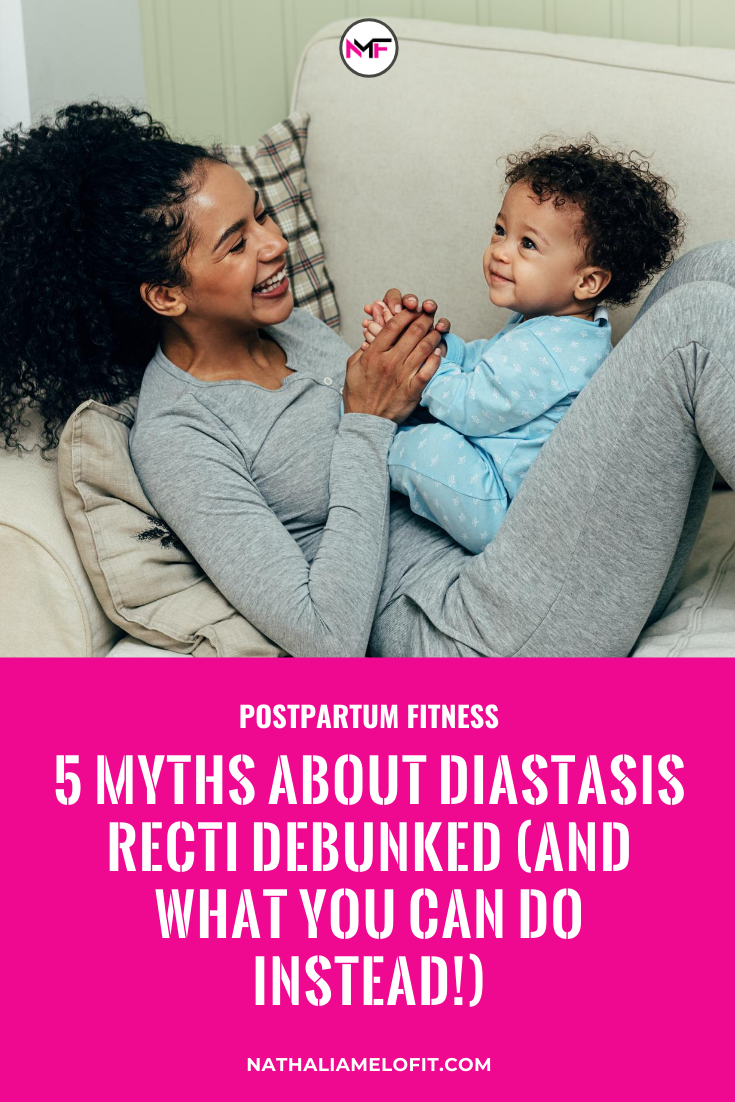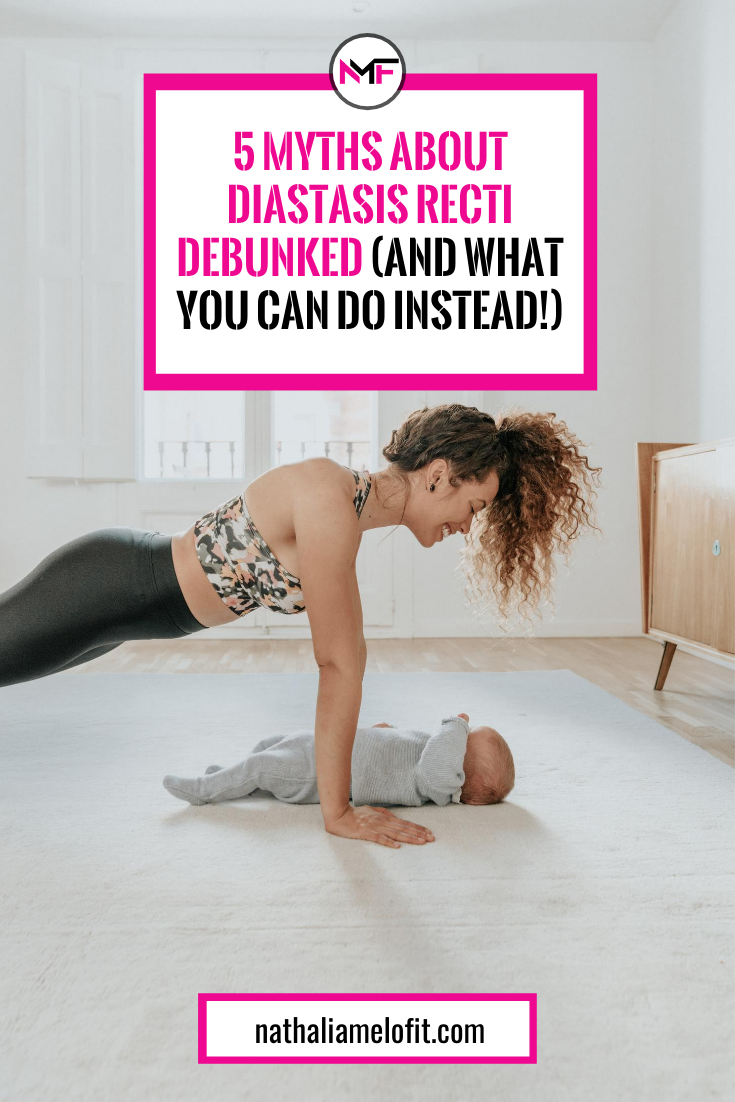Today’s post is going to walk you through the myths of Diastasis Recti. 5 myths to be exact! The purpose of this post is to serve a guiding light in the sea of information out there about Diastasis Recti.
Diastasis Recti has been getting a lot of attention from moms around the world. Although it is great that women are becoming more familiar with its existence, the overload of incorrect information has started sending some women into panic mode for no reason.
Before digging deeper into the 5 myths about Diastasis Recti, it is important to understand what exactly diastasis recti (DRA) is. DRA is a condition where the abdominal muscles are separated due to the widening of the connective tissue (linea alba) in between the two sides of your rectus abdominis (aka your six-pack muscles). The widening and loss of elasticity in the connective tissue can cause the abdominal content to bulge. You can read a little bit more about DRA in this and this blog I have written.
Here are 5 Myths about Diastasis Recti
And hopefully, you will also learn whether or not you should be panicking about having DRA!
Myth #1: You can prevent Diastasis Recti
Diastasis recti cannot be prevented during pregnancy. It is a natural process of pregnancy. It’s the natural process of your body making room for your growing baby. According to studies, up to 100% of expectant mothers will have an abdominal separation by the time they reach their third trimester, and over 60% of women will still have it 6 weeks postpartum. So, this is clearly not something you should be worried about preventing. You should, however, avoid putting unnecessary pressure on the connective tissue.
What you can do?
Although we have already addressed that DRA cannot be prevented, it does not mean that you should just do whatever you want when it comes to training. There are some things you can and should be doing to prevent further stress of the connective tissue (linea alba) during pregnancy and immediately postpartum. Avoiding movements that put unnecessary stress on the area and avoiding exercises that might increase the pressure in your abdominal cavity ( IAP -Intra Abdominal Pressure) is a great way to start. It also important to keep in mind that these exercises might only need to be avoided or scaled back for a limited period of time. That means you don’t have to worry about NEVER being able to do them again.
Myth #2: A list of 4-5 exercises will cure your DRA
Firstly, In my personal and professional opinion Diastasis recti isn’t an illness or a disease that needs ‘curing’. Instead, it’s a natural process our bodies go through during pregnancy. It happens due to the stretching of the connective tissue and separation of the abdominal muscles as already explained previously.
Assuming that a list of 4-5 exercises breathing exercise alone will ‘cure’ diastasis recti without progressing those patterns learned into more functional movements where you can add load is like expecting to build muscles without challenging your muscles with more load.
Breathing exercises are great to start. Ultimately you need to be able to translate what you have learned from them into your squat, deadlift, farmers walk, and even crunches!
What you can do?
The 4-5 exercises that are being claimed to ‘cure your diastasis recti’ are in fact just the foundation that will begin your journey to the rehabilitation of your DRA. You learn the basics, then you apply those basic principles to more complex movements (Squat, deadlift, step-ups). Once you master those using either very light load or just your body weight, you then add load.
These are the basic principles of progressive overload, and it shouldn’t be different when rehabbing diastasis recti.
This is also why it is so important to make sure you are working with a trainer who specializes in moms so that the progression can be done correctly and safely.
Myth #3: My OBGYN diagnosed me with DRA at my 6 weeks check, so I probably still have it 1 year postpartum
As I mentioned at the beginning of this blog, nearly 60% of women will have diastasis recti at 6 weeks postpartum. It is very likely that when you will have it when getting measured by your OBGYN or midwife at your 6 weeks check.
At 1 year postpartum the percentage of women who still have diastasis recti drops to just over 35%.
What you can do?
If you are concerned about DRA, my recommendation would be to go see the professional who can properly diagnose you DRA. They will be able to better give strategies to manage your DRA. Also, this professional is NOT your OBGYN but a Pelvic Floor Physical Therapist.
The combination of the strategies given by a Pelvic Floor Physical Therapist and the programming knowledge of a Pre and Postpartum Fitness Trainer will be the winning formula for achieving the physique goals in a sustainable and safe manner.
Myth #4: It is only about the gap
I often get messages on social media from women overly concerned about their gap and how this means they have diastasis recti and they are broken.
Firstly, having diastasis recti doesn’t mean you are broken or damaged.
Also, broadly speaking a clinical diastasis recti is normally when there is a gap of at least 2-2 cms (roughly 2 fingers width). The one-finger gap most women panic about is very unlikely to be a major issue and here is why:
Most women don’t know what their baseline gap was prior to pregnancy. What this means is that nobody really knows how many fingers wide the separation of their rectus abdominis was before getting pregnant. This will vary from person to person regardless of having kids or not.
Even if you have the 2 cm gap, but have a lot of elasticity on the connective tissue, it might still not be an issue that most Pelvic Floor Physical Therapists would be overly concerned about. You might have a 2cm gap, but have a functional diastasis, and what that means is that the gap doesn’t affect your movements.
On the other hand, there are some rare cases where a woman might have a less than 2cm gap, but have no elasticity in the connective tissue… and, this might mean that the woman has a diastasis recti.
What you can do?
Instead of focusing so much on the gap, pay attention if you can’t perform movements you used to be able to prior to pregnancy. For example:
- Laying flat on your back and lifting your legs off the ground
- Laying flat on your back and lifting your legs and head…
DO NOT try this movement without proper coaching from either a PFPT (Pelvic Floor Physical Therapist). Or an experienced Pre and Postnatal coach.
Myth #5: Wearing a corset/waist trainer will cure DRA
If I had a dollar every time I got asked this question I would be a freaking millionaire! This is a misconception about diastasis recti rehabilitation that I just wish would go away.
That is because more times than not new moms will purchase a waist trainer that is far too tight for them! This is actually detrimental to their pelvic floor health. That huge squeeze on the abdominal area will push the pressure down towards the pelvic floor and towards the diaphragm. (Imagine squeezing a balloon in the middle!)
It is also important to note that studies have shown that wearing a corset/waist trainer/ tape only will not improve DRA.
What you can do?
Exercises targeting the deep core muscles (Transversus Abdominis- TRA) are significantly more effective than wearing a corset/waist trainer. Start with breathing movements to learn how to engage your deep core muscles. Slowly progress into more advanced movements with the engagement of those muscles.
I hope this blog has helped you clarify some misinformation about diastasis recti. Plus why it is so important to work with professionals who know how to properly address this condition. Debunking these myths about Diastasis Recti will help so many women better understand DRA! And hopefully, help you panic a bit less when you have it.
Let’s face it, I talk a lot about the importance of working with a pre and postnatal certified trainer. It’s a no-brainer why you need one, especially when you are rehabilitating post-pregnancy. While I talk a lot about how you need one, I don’t often talk about where you can find one… But today I wanted to share with you my signature program. Giving you all access to my experience as a pre and postnatal trainer!
The Mother Strong League is my program for moms! It will take you through a step by step progression over the months. You learn the basics and are able to perform movements with the proper progressive overload programming.
We have programs for pregnant moms for each trimester, making the adequate modifications their bodies need. And postpartum programs for moms who either have recently had a baby or had a baby years ago. Our different programs will cater to your specific needs! All you have to do is take a medical questionnaire when you join.
Come find out which program is right for YOU! CLICK HERE to learn more.
Help other mamas understand the myths surrounding Diastasis Recti. Save this post to Pinterest!


